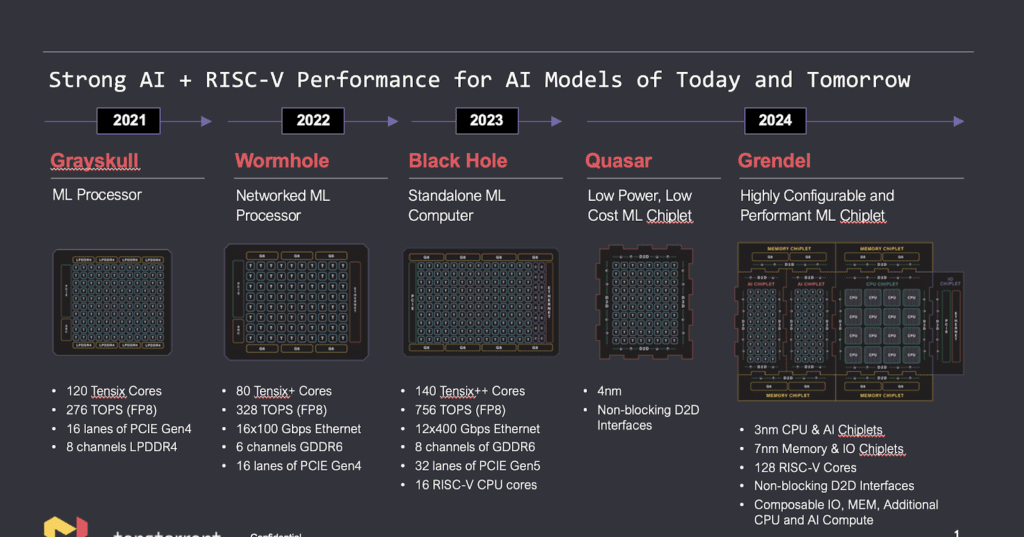TL;DR:
- Tenstorrent opts for Samsung’s SF4X technology for its Quasar chiplet.
- Quasar chiplet to feature 80 Tensix cores designed for versatile AI workloads.
- Samsung’s SF4X is tailored for high-performance computing, maximizing performance.
- Exact performance details are undisclosed, but speculations point to formidable capabilities.
- Quasar chiplets are positioned as low-cost, low-power solutions for machine learning.
- Strategic partnership expected to accelerate AI and RISC-V innovation.
- Tenstorrent secures $100 million in funding, co-led by Hyundai and Samsung Catalyst Fund.
Main AI News:
Tenstorrent, a trailblazing player in the field of machine learning, has unveiled an exciting development in its quest for low-cost, low-power AI solutions. The company’s latest revelation centers around its forthcoming Quasar chiplet, set to redefine the landscape of artificial intelligence workloads. In a strategic move, Tenstorrent has chosen Samsung’s cutting-edge SF4X (4 nm-class) process technology for this ambitious endeavor, further solidifying the synergy between innovation and technology giants.
The Quasar chiplet, a significant addition to Tenstorrent’s roadmap, promises to deliver unmatched performance. With a staggering arsenal of at least 80 Tensix cores, all harnessed within the framework of the RISC-V instruction set architecture, this chiplet is designed to seamlessly execute AI workloads in multiple formats, including BF4, BF8, INT8, FP16, and BF16. What sets Tenstorrent’s Quasar apart is its ability to operate in clusters, complemented by non-blocking die-to-die interfaces, ensuring optimal performance and versatility.
Samsung’s SF4X process technology, renowned for its prowess in high-performance computing applications, is the chosen enabler for Tenstorrent’s Quasar chiplet. Tailored to accommodate high clocks and voltages, this technology is poised to unlock the full potential of Tenstorrent’s vision for AI innovation.
While Tenstorrent remains tight-lipped about the exact performance metrics of the Quasar chiplet, industry experts speculate that it could rival the capabilities of the Wormhole chiplet, boasting 328 FP8 TOPS performance. This assumption is grounded in the shared count of 80 Tensix cores and the use of performance-enhanced process technology, offering a tantalizing glimpse into the chiplet’s capabilities.
Tenstorrent strategically positions the Quasar chiplets as an ideal solution for low-power, cost-effective machine learning applications. The burning question, however, remains: Will the company harness every ounce of performance or opt for an alternative power strategy to cater to its diverse clientele?
Marco Chisari, head of Samsung’s U.S. Foundry business, expressed his enthusiasm, saying, “Samsung Foundry is expanding in the U.S., and we are committed to serving our customers with the best available semiconductor technology.” This partnership between Tenstorrent and Samsung promises to expedite innovation in RISC-V and AI, catering to the burgeoning demand in data centers and automotive solutions. Chisari concluded by stating, “We look forward to working together and serving as Tenstorrent’s foundry partner,” underlining the mutual commitment to advancing technology.
A notable facet of Tenstorrent’s alliance with Samsung is its recent achievement of securing $100 million in funding, co-led by Hyundai Motor Group and the Samsung Catalyst Fund. This underscores the convergence of interests between the automotive and semiconductor giants, fueling speculation that Samsung’s involvement may extend beyond financial support into chip production for Tenstorrent, a strategic move with far-reaching implications.

Source: Tenstorrent
Conclusion:
The collaboration between Tenstorrent and Samsung represents a significant step forward in the AI and semiconductor market. With the adoption of Samsung’s cutting-edge technology, Tenstorrent’s Quasar chiplet is poised to offer a powerful, cost-effective solution for AI workloads. This strategic partnership and substantial funding highlight the growing demand for advanced AI solutions and the potential for further integration between automotive and semiconductor industries. The market can anticipate groundbreaking innovations and increased competition in the AI sector.
